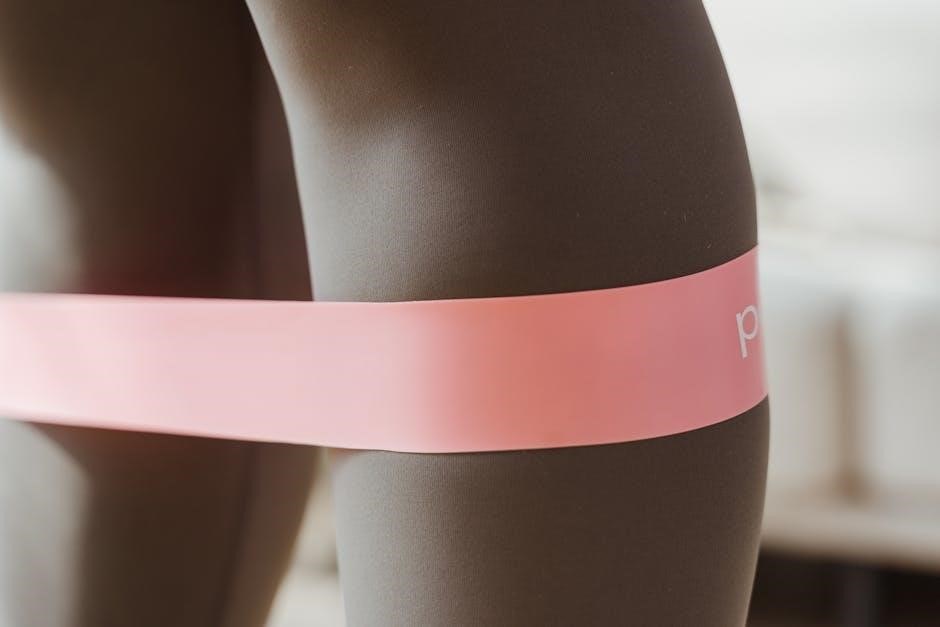Stretching and strengthening exercises target the iliotibial band, essential for preventing and treating ITBS. A dedicated routine combines stretching, foam rolling, and progressive strengthening to enhance flexibility and reduce pain.

What is the Iliotibial Band?
The iliotibial (IT) band is a thick, fibrous ligament running down the outer thigh, from the hip to the knee. It provides stability and support during movements like running, cycling, and walking. Composed of dense connective tissue, the IT band reinforces the tensor fasciae latae muscle, aiding in knee flexion and hip abduction. While durable, repetitive friction over the lateral femoral condyle can cause inflammation, leading to IT band syndrome. Understanding its structure and function is crucial for effective management and rehabilitation.

Importance of Stretching and Strengthening Exercises
Stretching and strengthening exercises are crucial for managing IT band syndrome and preventing future issues. Stretching improves flexibility, reduces tightness, and minimizes friction between the IT band and surrounding structures. Strengthening, particularly of the hip and core muscles, enhances stability and proper movement patterns. Together, these exercises help alleviate pain, promote healing, and restore functional mobility, making them essential for both rehabilitation and long-term prevention of IT band-related discomfort.
Cause and Symptoms of Iliotibial Band Syndrome
Caused by inflammation and irritation of the iliotibial band due to overuse or repetitive friction. Symptoms include outer knee pain, swelling, and discomfort during activities like running or cycling.
Common Causes of IT Band Syndrome
IT Band Syndrome often results from overuse, repetitive friction, or poor training habits. Activities like running, cycling, or repetitive knee bending can cause inflammation. Sudden increases in exercise intensity or duration are common triggers. Biomechanical issues, such as hip or knee misalignment, may contribute. Weak hip muscles or tight IT bands can also lead to irritation. Running on uneven surfaces or wearing improper footwear exacerbates symptoms. These factors combine to create friction and inflammation, leading to IT Band Syndrome, especially in endurance athletes and active individuals;

Identifying Symptoms of IT Band Syndrome
Common symptoms include sharp or dull pain on the outer knee, swelling, or a snapping sensation. Pain often worsens with repetitive knee bending, such as during running or cycling; Tenderness may be felt along the lateral thigh or knee. Activities like climbing stairs or prolonged sitting can exacerbate discomfort. Swelling or redness near the knee may occur in severe cases. Pain typically subsides with rest but recurs with activity, especially in endurance athletes. Early recognition is crucial for effective management and recovery.
Stretching Exercises for the Iliotibial Band
Daily stretching reduces IT band tightness and improves flexibility. Exercises include standing stretches, side-leaning stretches, and Figure-4 stretches for the piriformis muscle to alleviate tension.
Standing Iliotibial Band Stretch
The standing IT band stretch targets the lateral thigh. Cross your uninjured leg over the injured one, bend down, and touch your toes. Hold for 30 seconds, ensuring a gentle stretch without pain. Perform 2-3 sets daily to improve flexibility and reduce tightness. This exercise is ideal for runners and cyclists to prevent ITBS symptoms. Consistency is key for long-term relief and muscle balance.
Side-Leaning Iliotibial Band Stretch
The side-leaning stretch effectively targets the IT band. Stand with feet shoulder-width apart, shift hips to one side, and lean toward the opposite direction. Hold for 20-30 seconds, then switch sides. This stretch enhances flexibility and reduces tightness in the lateral thigh. Regular practice helps prevent ITBS symptoms, especially for athletes. Perform 2-3 sets daily for optimal results and improved muscle balance in the hips and thighs.
Figure-4 Stretch for Piriformis Muscle
The Figure-4 stretch targets the piriformis muscle, which is closely linked to IT band tension. Sit on the floor with your affected leg crossed over your other thigh, forming a “4” shape. Gently lean forward to stretch the posterior hip. Hold for 20-30 seconds and repeat 2-3 times. This stretch helps relieve piriformis tightness, which can contribute to IT band irritation. Regular practice improves hip mobility and reduces the risk of ITBS, especially for runners and cyclists.

Strengthening Exercises for IT Band Syndrome
Strengthening exercises focus on improving hip and knee stability to reduce IT band tension. Clamshells, side-lying leg lifts, and wall squats are effective for addressing ITBS symptoms and preventing recurrence.
Clamshell Exercise
The clamshell exercise targets the hip muscles, particularly the gluteus medius, to improve stability and reduce IT band tension. Lie on your side with knees bent and ankles together. Slowly lift the top knee while keeping the feet touching, avoiding hip rotation. Hold for 2-3 seconds, then lower. Perform 3 sets of 10-15 repetitions. Maintain proper form to avoid lower back strain. This exercise strengthens the hips, providing better support for the IT band and reducing the risk of syndrome recurrence.
Side-Lying Leg Lifts
Side-lying leg lifts effectively strengthen the hip abductors, crucial for IT band stability. Lie on your side with legs straight and feet touching. Lift the top leg slowly, keeping it straight, then lower it without touching the bottom leg. Perform 3 sets of 10-12 repetitions on each side. This exercise enhances hip strength, improving running mechanics and reducing IT band strain. Proper form ensures targeting the correct muscles without overloading the knee or lower back.
Wall Squats for Knee Stabilization
Wall squats are an excellent exercise for improving knee stability and strengthening the surrounding muscles. Stand with your back against a wall and feet shoulder-width apart. Slowly slide down into a squat, keeping your knees in line with your toes. Hold for 10-15 seconds, then return to the starting position. Perform 3 sets of 10-12 repetitions. This exercise strengthens the quadriceps, hamstrings, and glutes, which are essential for supporting the knee and reducing IT band strain. Proper form ensures effective muscle engagement and injury prevention.

Foam Rolling for IT Band Relief
Foam rolling targets the IT band, reducing tension and improving circulation. Use a 6-inch roller, rolling from the hip to just above the knee. Apply moderate pressure for relief.
How to Use a Foam Roller
Using a foam roller for IT band relief involves rolling the lateral thigh from the hip to just above the knee; Place the roller under your thigh, supporting your body with your arms and uninjured leg. Slowly move the roller downward, applying moderate pressure. Repeat the motion for 2-3 minutes, focusing on areas of tension. Use your body weight to control pressure, easing off if discomfort arises. This technique helps reduce muscle tightness and improves circulation, aiding in recovery and pain relief.
Self-Myofascial Release Techniques
Self-myofascial release for the IT band involves using tools like foam rollers or your own body weight to release tension. Lie on your side with the affected leg up, placing the roller beneath your thigh. Slowly roll from the hip to just above the knee, focusing on tender areas. Apply gentle pressure and repeat for 2-3 minutes. This technique reduces muscle tightness, improves circulation, and alleviates pain; Regular practice enhances flexibility and supports overall muscle function, making it a key component of IT band syndrome recovery and prevention.

Rehabilitation Protocol for IT Band Syndrome
A structured rehabilitation approach for IT Band Syndrome includes three phases: acute, strengthening, and return to activity. Each phase focuses on incremental healing and functional recovery process.
Phase 1: Acute Phase
The acute phase focuses on reducing pain and inflammation while minimizing further irritation to the IT band. Initial steps include ice therapy, rest, and anti-inflammatory medications to control symptoms. Gentle stretching exercises, such as standing and side-leaning stretches, are introduced to improve mobility without aggravating the condition. Foam rolling is also incorporated for self-myofascial release, promoting blood flow and reducing muscle tension. This phase emphasizes pain management and laying the groundwork for more intensive rehabilitation in later stages.
Phase 2: Strengthening Phase
This phase focuses on building strength and stability around the hip and knee to support the IT band. Exercises like clamshell exercises, side-lying leg lifts, and wall squats are introduced to target the gluteal muscles and improve knee stabilization. Progression to resistance bands or light weights may occur, with a focus on controlled movements to avoid irritation. The goal is to enhance muscle endurance and promote proper biomechanics, reducing the risk of recurring symptoms. Supervision by a physical therapist is often recommended for optimal results.
Phase 3: Return to Activity
This phase focuses on gradually returning to normal activities or sports, ensuring the IT band is pain-free and strong. Low-impact exercises like cycling or swimming are introduced to maintain fitness without stress. Progression to dynamic movements, such as agility drills or functional exercises, helps restore full mobility. Emphasis is placed on proper technique and avoiding overexertion. Patients are encouraged to continue maintenance stretching and strengthening routines to prevent recurrence. Monitoring symptoms and adjusting activity levels as needed is crucial during this transition back to full activity.
Prevention of IT Band Syndrome
Preventing ITBS involves proper warm-ups, footwear adjustments, and modifying training routines. Consistent stretching and strengthening exercises, along with avoiding overtraining, help reduce the risk of developing the syndrome;
Proper Warm-Up Routine
A dynamic warm-up is crucial for preventing ITBS. Start with light cardio like jogging or cycling for 5-10 minutes. Incorporate leg swings, high knees, and hip circles to activate the lower body. Focus on stretching the IT band, hamstrings, and quadriceps. Use foam rolling to release tension in the lateral thigh. Finish with functional movements like lunges or step-ups to prepare for activity. A consistent warm-up routine reduces muscle tightness and improves flexibility, lowering the risk of ITBS.
Footwear and Training Modifications
Proper footwear and training adjustments are vital for preventing ITBS. Wear shoes with adequate arch support and cushioning, especially if running or cycling. Replace worn-out shoes regularly to avoid uneven wear. Gradually increase training intensity and mileage to allow the IT band to adapt. Avoid repetitive movements on hard surfaces and opt for softer terrain when possible. Incorporate cross-training with low-impact activities like swimming or cycling. Ensure proper running biomechanics, such as maintaining a midfoot strike, to reduce IT band stress. These modifications help prevent irritation and promote long-term recovery.

Downloadable PDF Resources
Downloadable PDF resources provide comprehensive guides for iliotibial band exercises, including illustrated stretching and strengthening routines, foam rolling techniques, and instructions for treating IT band syndrome effectively.
Comprehensive Exercise Guides
Downloadable PDF guides offer detailed routines for iliotibial band exercises, including stretching, strengthening, and foam rolling techniques. These resources often feature step-by-step instructions, illustrations, and progressive plans to address IT band syndrome. They cater to various fitness levels, providing modifications and tips for safe execution. Many guides emphasize the importance of consistency and proper form to enhance flexibility, reduce pain, and improve overall knee and hip function. These comprehensive guides are ideal for individuals seeking structured rehabilitation or preventive exercise programs.
Illustrated Stretching and Strengthening Routines
PDF resources provide clear, visual instructions for iliotibial band exercises, combining detailed illustrations with step-by-step guidance. These guides cover essential stretches like standing and side-leaning IT band stretches, along with strengthening exercises such as clamshells and side-lying leg lifts. Visual aids ensure proper form, reducing injury risk and enhancing effectiveness. The routines are organized progressively, allowing users to gradually increase intensity and focus on specific muscle groups for comprehensive recovery and prevention of IT band syndrome.